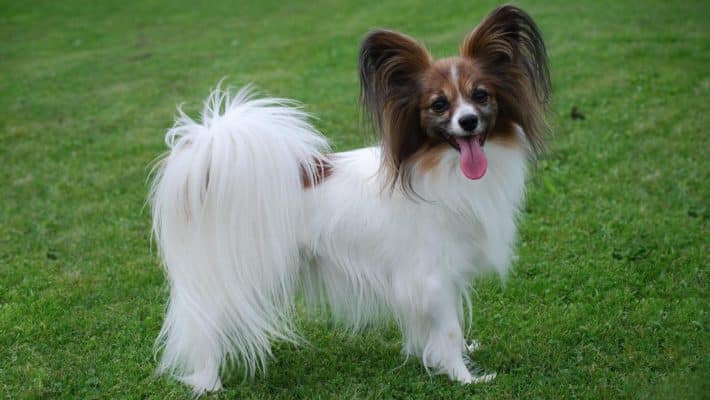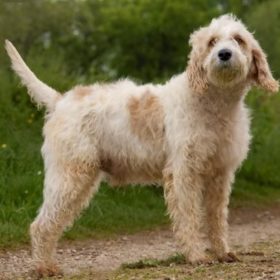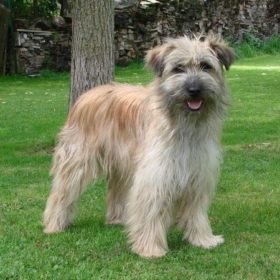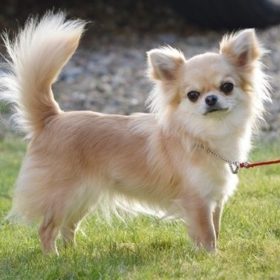Continental Toy Spaniel

Continental Toy Spaniels are active, friendly, and carefree. They are almost always enthusiastic, agile, and playful, with great curiosity to explore everything around them. They have a lot of energy and cheerfulness. At the same time, they are very sociable, attentive, and affectionate dogs.
Table of Contents
Breed Information
| Another Name | Papillon, Phalène (drop ear type), Epagneul Nain Continental |
| Origin | Belgium/France |
| Height | 20-28 cm |
| Weight | 1.5-5 kg |
| Fur | Long |
| Color | White with spots of any color |
| Lifespan | 12-16 years |
| FCI Classification | Companion and Toy Dogs |
| Group | Small breed or decorative dogs, dogs for apartments, dogs for children |
| Price | From $900 |
Breed Photos
Origin History
There is a long-standing discussion about the history of the Continental Toy Spaniel’s origin because there are two versions of the origin of this breed. According to the first version, long-standing ancestors of this breed were imported to Europe from China. It is said that representatives of this breed were the favorites of aristocrats. Black and white Toy Spaniels belonged to the French King Louis XIV, and the English kings Charles I and Charles II owned black and tan spaniels. Over time, the change of power in England from a Catholic monarchy to a Protestant monarchy pretty much led to the disappearance of royal interest in toy spaniels. It was because Protestant aristocrats preferred to keep pugs in the royal court. Later the popularity of Toy Spaniels began to revive, and they regained their fame.
Another version of the Continental Toy Spaniel’s origin says that the ancestors of this breed are the dogs of the Papillon breed, which were bred and popularized in Belgium and France. The Continental Toy Spaniel breed was officially recognized by the Fédération Cynologique Internationale in 1937.
Appearance
The Continental Toy Spaniel is a small ornamental breed with a luxurious coat, proud posture, and airy gait. The coat of the Continental Toy Spaniel deserves special attention – it is straight and shiny, hanging down in thick waves. On the front of the limbs and the head and muzzle, the hair is denser and shorter. The coat color is white with spots of any color on the back, tail, ears, and around the eyes. The Toy Spaniel’s most common colors are black and white, white-sable, and tricolor, which consists of a combination of sable, black and white.
The Continental Toy Spaniel is a thin-boned dog with a body slightly longer than its height. He has a beautiful thin muzzle, large almond-shaped eyes of dark color. The look is expressive and a little wary, but at the same time very kind. The ears are the main distinguishing feature of the Toy Spaniel. Depending on the ears’ shape, toy spaniels are divided into two subspecies – Papillon and Phalen. Papillon is a representative of the breed with large standing ears, resembling the wings of a butterfly, falen is a representative of the breed with floppy ears in the shape of folded wings of a moth.
Character
Continental Toy Spaniels are active, friendly, and carefree. They are almost always enthusiastic, agile, and playful, with great curiosity to explore everything around them. They have a lot of energy and cheerfulness.
At the same time, they are very sociable, attentive, and affectionate dogs. In general, the Continental Toy Spaniel is an ideal pet for those who are thinking about getting a little friend. They are loyal and devoted friends and love to spend time with their owners. If left alone, they get bored and do their best to get attention.
Another characteristic of the little spaniel is its loud, unrestrained barking. These pets always have something to say. When they are amused and happy, they bark when they demand attention to themselves, when they are trying to warn about something, and sometimes they bark just for no reason. Regular training can help calm these babies, where they can be taught what situations it is appropriate to raise your voice and in what situations it is better to refrain.
Care
Due to their small size, Continental Toy Spaniels are ideal for apartment living. They are neat and clean by nature, so grooming is not difficult. As part of hair care, it is recommended to brush the little spaniel about three times a week and during the molting period daily. You should also make sure that the hair on the legs, buttocks, and behind the ears is not tangled since these are the places where it is longer. Special coat care sprays can be used to help keep your dog’s coat shiny and silky. Continental Toy Spaniels have very sensitive skin, so frequent bathing is not recommended.
The Toy Spaniel’s teeth also require special care – they must be brushed weekly. Also, regular professional oral cleanings are recommended. Dental care should begin at a young age to ensure good hygiene and minimize the risk of oral problems throughout life. It is also important not to forget regular ear and eye hygiene.
Continental Toy Spaniels are a moderately active breed. They like to go for walks, but they do not require long periods outside. Less than one hour is enough time for them to get enough exercise.
Training
One of Continental Toy Spaniels’ main advantages is their sharp mind and intelligence, which makes them easy to train. They pick up information on the fly, learn commands and various tricks. A consistent training program of positive reinforcement and rewards can provide results quickly after just a few training sessions. Toy Spaniels are recommended for physical and mental development opportunities, such as special puzzle toys, the play with which will awaken your pet’s curiosity and require them to be smart.
Without proper training, toy spaniels can grow up to be very capricious, so you must take control of their education from an early age. At the same time, it is necessary to remember that lessons with these sensitive creatures should be gentle and without aggression.
Common Diseases
Despite its small size and fragile appearance, the Continental Toy Spaniel has good health. On average, the life expectancy of a pet of this breed is from 12 to 16 years. With proper care and housing, many diseases can be avoided throughout the life of the Toy Spaniel.
Baby spaniels are prone to congenital patella dislocation, progressive retinal atrophy, hereditary ataxia, hypoglycemia, and follicular black hair dysplasia.
It is also important to know that Continental Toy Spaniels do not tolerate heat and cold. You should avoid exposing your pet to hot sunlight during the summer, as he may get heatstroke. To avoid this, it is necessary to walk with this baby early in the morning or late in the evening. For walks in winter, the Toy Spaniel should be dressed in warm clothes.
Nutrition
As with other breeds, good nutrition plays a vital role in keeping the Continental Toy Spaniel. The pet’s diet must be nutritious and balanced. Even though the Toy Spaniel can be fed with dry food, it prefers natural food. The diet of representatives of this breed should consist of lean raw meat, fish, fresh vegetables, and porridge. Of porridge, Toy Spaniels prefer buckwheat, oatmeal, and rice. It is strictly forbidden to offer pet bones, pork, butter, confectionery, and flour products.
 Briquet Griffon Vendéen
Briquet Griffon Vendéen Lakeland Terrier
Lakeland Terrier Pyrenean Sheepdog
Pyrenean Sheepdog Ca de Bou
Ca de Bou Carpathian Shepherd Dog
Carpathian Shepherd Dog Chihuahua
Chihuahua


